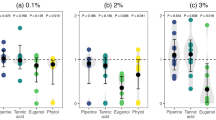Abstract
Field observations revealed that flowers of Osmanthus fragrans attract few insect species despite their strong scent and vivid coloration (yellowish orange). Floral volatiles of the plant were thus examined for suspected repellency to Pieris rapae, a potential visitor that never visits this flower. The influence of odor components on the foraging behavior of adult butterflies was assessed by two behavioral bioassays: proboscis extension reflex (PER) in response to olfactory stimuli and the frequency of visits to artificial flowers. In the PER bioassays, a binary mixture composed of a test material and 2-phenylethanol (a positive standard compound) was used, and the negative effect of test materials was appraised based on the degree of suppression caused compared with the original PER performance evoked by 2-phenylethanol alone. Isopentane extract of the flower exhibited significant deterrency in the PER test and remarkable repellency in the flower-visiting experiment, thereby suggesting the presence of a repellent(s) in the floral volatiles. Fractionation of the extract by silica gel column chromatography yielded an active fraction (based on PER performance), which, upon GC and GC-MS analyses, was found to consist of γ-decalactone, β-ionone, and linalool oxide (LO) isomers (furanosides and pyranosides) as major components together with small amounts of linalool and α-ionone. γ-Decalactone was strongly deterrent in the PER test, and β-ionone and all LO isomers were weakly deterrent, while the other compounds exhibited no deterrency. In the flower-visiting tests, γ-decalactone showed notable repellency, whereas β-ionone had no repellent effect. Among the LO isomers, at least furanosides (cis/trans mixture) and cis-pyranoside were found to be weakly repellent. On the other hand, the butterfly showed strong to weak EAG responses to LO furanosides, cis-LO pyranoside, γ-decalactone, and β-ionone in decreasing order of intensity. The present results clearly indicate that the repellency of a compound is correlated with its deterrent effect on PER but not necessarily with antennal sensitivity.
Similar content being viewed by others
REFERENCES
Cantelo, W. W., and Jacobson, M. 1979. Phenylacetaldehyde attracts moths to bladder flower and to blacklight traps. Environ. Entomol. 8:444–447.
Ding, D., Zhu, M., Huang, Z., and Song, Z. 1989. Headspace analysis of Osmanthus fragrans Lour. J. Essent Oil Res. 1:295–297.
Dobson, H. E. M. 1994. Floral volatiles in insect biology, pp. 48-70, in E. A. Bernays (ed.). Insect-Plant Interactions, Vol. V. CRC Press, Boca Raton, Florida.
Evans, K. A., and Allen-Williams, L. J. 1992. Electroantennogram responses of the cabbage seed weevil, Ceutorhynchus assimilis, to oilseed rape, Brassica napus ssp. oleifera, volatiles. J. Chem. Ecol. 18:1641–1659.
Gabel, B., Thiery, D., Suchy, V., Marion-Poll, F., Hradsky, P., and Farkas, P. 1992. Floral volatiles of Tanacetum vulgare L. attractive to Lobesia botrana Den. et Schiff. females. J. Chem. Ecol. 18:693–701.
Gabel, B., Marion-Poll, F., Suchy, V., Roehrich, R., Hradsky, P., and Thiery, D. 1994. Olfactory responses of Lobesia botrana females (Lepidoptera: Tortricidae) to Tanacetum vulgare (Asteracea) flower extracts and fractions. Entomol. Probl. 25:1–7.
Haynes, K. F., Zhao, J. Z., and Latif, A. 1991. Identification of floral compounds from Abelia grandiflora that stimulate upwind flight in cabbage looper moths. J. Chem. Ecol. 17:637–646.
Heath, R. R., Landolt, P. J., Dueben, B., and Lenczewski, B. 1992. Identification of floral compounds of night-blooming jessamine attractive to cabbage looper moths. Environ. Entomol. 21:854–859.
Honda, K. 1973. Olfactory response of adults of butterflies to odorous compounds I. Sasakia charonda Hewitson (In Japanese). Nat. Insect 8:21–24.
Honda, K. 1976. The role of olfactory and color senses in the feeding behavior in the adult of Nymphalis xanthomelas japonica Stichel (Lepidoptera: Nymphalidae), with description of the preference on colors of flowers in the flower-visiting behavior (in Japanese with English summary). Trans. Lepid. Soc. Jpn. 27:52–58.
Honda, K., Ômura, H., and Hayashi, N. 1998. Identification of floral volatiles from Ligustrum japonicum that stimulate flower-visiting by cabbage butterfly, Pieris rapae. J. Chem. Ecol. 24:2167–2180.
Ilse, D. 1928. Über den Farbensinn der Tagfalter. Z. Vergl. Physiol. 8:658–692.
Kandori, I., and Ohsaki, N. 1996. The learning abilities of the white cabbage butterfly, Pieris rapae, foraging for flowers. Res. Popul. Ecol. 38:111–117.
Kay, Q. O. N. 1976. Preferential pollination of yellow-flowered morphs of Raphanus raphanistrum by Pieris and Eristalis spp. Nature 261:230–232.
Knudsen, J. T., Tollsten, L., and BergstrÖm, L. G. 1993. Floral scents-a checklist of volatile compounds isolated by head-space techniques. Phytochemistry 33:253–280.
Miyakawa, M. 1976. Flower-visiting behavior of small white butterfly, Pieris rapae crucivora. Annot. Zool. Jpn. 49:261–273.
Myers, J. H., and Walter, M. 1970. Olfaction in the Florida queen butterfly: Honey odour receptors. J. Insect Physiol. 16:573–578.
Ômura, H., Honda, K., and Hayashi, N. 1999. Chemical and chromatic bases for preferential visiting by the cabbage butterfly, Pieris rapae, to rape flowers. J. Chem. Ecol. 25:1895–1906.
Raguso, R. A., Light, D. M., and Pickersky, E. 1996. Electroantennogram responses of Hyles lineata (Sphingidae: Lepidoptera) to volatile compounds from Clarkia breweri (Onagraceae) and other moth-pollinated flowers. J. Chem. Ecol. 22:1735–1766.
Scherer, C., and Kolb, G. 1987a. Behavioral experiments on the visual processing of color stimuli in Pieris brassicae L. (Lepidoptera). J. Comp. Physiol. A 160:645–656.
Scherer, C., and Kolb, G. 1987b. The influence of color stimuli on visually controlled behavior in Aglais urticae L. and Pararge aegeria L. (Lepidoptera). J. Comp. Physiol. A 161:891–898.
Vaidya, V. G. 1969. Form perception in Papilio demoleus L. (Papilionidae, Lepidoptera). Behaviour 33:212–221.
Zhu, Y., Keaster, A. J., and Gerhardt, K. O. 1993. Field observations on attractiveness of selected blooming plants to noctuid moths and electroantennogram responses of black cutworm (Lepidoptera: Noctuidae) moths to flower volatiles. Environ. Entomol. 22:162–166.
Author information
Authors and Affiliations
Rights and permissions
About this article
Cite this article
Ômura, H., Honda, K. & Hayashi, N. Floral Scent of Osmanthus fragrans Discourages Foraging Behavior of Cabbage Butterfly, Pieris rapae. J Chem Ecol 26, 655–666 (2000). https://doi.org/10.1023/A:1005424121044
Issue Date:
DOI: https://doi.org/10.1023/A:1005424121044




